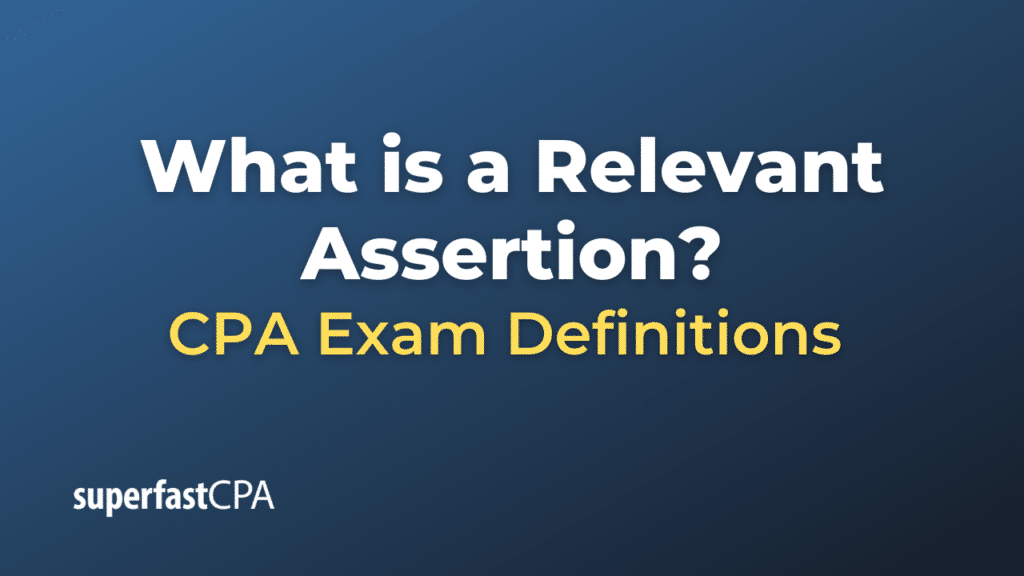Relevant Assertion
In the context of financial statement auditing, a “relevant assertion” is a representation or statement made by the management of a company regarding a particular element of the financial statements. These assertions form the basis upon which auditors design and execute their audit procedures.
Relevant assertions help auditors in determining where there might be potential misstatements in the financial statements and what type of evidence they need to gather to confirm or refute these assertions. Assertions can be related to account balances, transaction classes, and presentation and disclosure matters.
There are generally five categories of relevant assertions, as identified by professional auditing standards:
- Completeness: All transactions and accounts that should be presented in the financial statements are included. For example, ensuring that all sales made during the period are recorded.
- Accuracy/Valuation : Amounts and other data related to an entity’s financial elements have been recorded appropriately, and assets and liabilities are included in the financial statements at appropriate amounts. For example, verifying that accounts receivable reflect the correct amounts owed to the company.
- Existence/Occurrence: Assets, liabilities, and equity interests exist, and recorded transactions have occurred during the specified period. For instance, confirming that inventory quantities on the balance sheet are actually present in the company’s warehouse.
- Rights and Obligations: The entity holds rights to the assets, and liabilities are obligations of the entity. For example, ensuring that a building on the balance sheet is legally owned or controlled by the company.
- Presentation and Disclosure: Financial statement elements are appropriately classified, described, and disclosed. This might involve checking that the footnotes in the financial statements include all the required information and that items are presented in the correct accounts.
Auditors use these assertions to structure their audit approach. For every significant financial statement account or disclosure, auditors identify the relevant assertions, assess risks related to those assertions, and then determine the evidence they need to collect to confirm each assertion.
Example of a Relevant Assertion
Let’s consider the account “Accounts Receivable” (A/R) from a company’s balance sheet and see how auditors might approach relevant assertions with respect to this account.
Accounts Receivable Relevant Assertions:
- Completeness:
- Assertion: All sales transactions that resulted in an amount owed by the customer (receivable) have been recorded in the A/R account.
- Audit Procedure: Reviewing a subsequent period’s cash receipts to ensure that all amounts collected (and thus previously owed) were recorded as receivables at the balance sheet date.
- Accuracy/Valuation:
- Assertion: The amounts listed in the A/R ledger are accurate, and any necessary allowances for doubtful accounts have been appropriately estimated and recorded.
- Audit Procedure: Testing the process by which the company estimates its allowance for doubtful accounts, and potentially re-performing the estimate using historical data on uncollectible amounts.
- Existence/Occurrence:
- Assertion: Every amount listed as a receivable was indeed a valid sale and represents a real amount owed by a customer.
- Audit Procedure: Selecting a sample of A/R balances and confirming them directly with the customers to verify they acknowledge the debt.
- Rights and Obligations:
- Assertion: The company has a legal claim to the receivables listed, and there are no disputes that might challenge their rights to collect.
- Audit Procedure: Inquiring about any disputes with customers over amounts owed and reviewing any legal correspondence or documentation regarding disputed amounts.
- Presentation and Disclosure:
- Assertion: The A/R is properly classified on the balance sheet, and any significant terms, conditions, or collection risks are adequately disclosed in the notes to the financial statements.
- Audit Procedure: Reviewing the notes to the financial statements for appropriate disclosures and ensuring A/R is correctly classified as a current asset (unless there’s a valid reason for a long-term classification).
Example Scenario:
Let’s assume during the audit of a retail company, the auditor identifies a significant increase in the A/R balance compared to the prior year. The management asserts that this is due to a large sale made just before the year-end.
Using the relevant assertions:
- For Existence, the auditor will want to confirm that this large sale did indeed take place and that the receivable amount arose from a valid transaction. They might do this by examining the related sales documentation and potentially confirming the balance directly with the customer.
- For Accuracy, the auditor would verify the exact amount of the sale to ensure it matches the increase in the A/R ledger.
- Under Rights and Obligations, the auditor may investigate to ensure there are no disputes or conditions related to this sale that could affect the company’s right to collect the full receivable amount.
This example provides insight into how auditors use relevant assertions to structure their audit approach and gather evidence about specific financial statement accounts.













